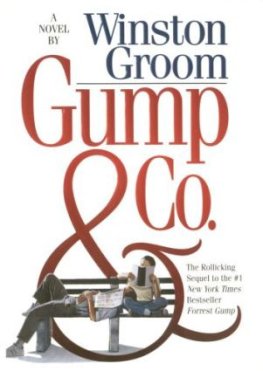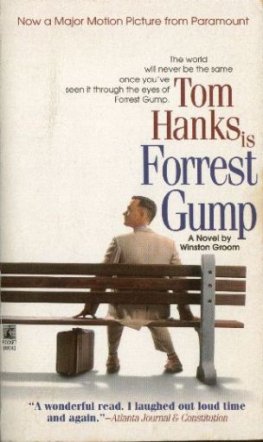Also by Winston Groom
Better Times Than These
As Summers Die Only
Conversations with the Enemy (with Duncan Spencer)
Forrest Gump
Shrouds of Glory
Gone the Sun
Gumpisms
Gump &Co.
Such a Pretty, Pretty Girl
The Crimson Tide

This book is dedicated to Carolina Montgomery Groom, age three.
from Papa
Copyright 2002 by Winston Groom
All rights reserved. No part of this book may be reproduced in any form or by any electronic or mechanical means, including information storage and retrieval systems, without permission in writing from the publisher, except by a reviewer, who may quote brief passages in a review. Any members of educational institutions wishing to photocopy part or all of the work for classroom use, or publishers who would like to obtain permission to include the work in an anthology, should send their inquiries to Grove/Atlantic, Inc., 841 Broadway, New York, NY 10003.
The Source Notes on pages 266267 are an extension of the copyright page.
Every effort has been made to contact all copyright holders. The publishers will be glad to make good in future editions any errors or omissions brought to their attention.
Published simultaneously in Canada Printed in the United States of America
FIRST EDITION
Library of Congress Cataloging-in-Publication Data Groom, Winston, 1944
A storm in Flanders : the Ypres salient, 19141918 : tragedy and triumph on the Western Front / Winston Groom1st ed. p. cm. Includes bibliographical references and index. ISBN 0-87113-842-5
1. Ypres, 1st Battle of leper, Belgium, 1914. 2. Ypres, 2nd Battle of leper, Belgium, 1915. 3. Ypres, 3rd Battle of leper, Belgium, 1917. 4. leper (Belgium)History, Military. 5. World War, 1914-1918--CampaignsBelgiumleper. I. Title. D542.Y5 G76 2002 940.4'144-----dc21 2002019433
Atlantic Monthly Press
841 Broadway
New York, NY 10003
02 03 04 05 109 8 76 5 43 2 1

The Ypres Salient in Belgian Flanders was the most notorious and dreaded place in all of the First World War, probably of any war in history. Typical was this British infantryman's reaction on being told that his battalion was to go there: "I mentioned Ypres and he cursed the place. Rumors of what waited ahead of us had disturbed everyone." This was said between men who had just gone through the ordeal of the Battle of the Somme, where more than 50,000 British soldiers became casualties on the first day.
From the autumn of 1914 to the autumn of 1918 Flanders was, in effect, a gigantic corpse factory. Hundreds of thousands died there for ground where gains were measured in mere yards. It was where, in 1914, the British professional army was virtually annihilated, though it had stopped the German drive to capture control of the English Channel. It was where, in 1915, the Germans first introduced the hideous novelty of poison gas. It was where the horrors of the flamethrower were unleashed. It was where, in 1917, during the most infamous battle of the war, Passchendaele, thousands fought and drowned in mud sometimes waist deep. And it was where, in 1918, all the ground gained over the previous bloody years was first lost in a great German assault and then, in an electrifying turnabout with the aid of newly arrived American divisions, was not only regained but precipitated the final destruction of the German war machine.
What people most remembered about the Salient was the smell: the ever-present odor of rotting humans, horses, mules, rats, and food mixed with the stench of excrement, lingering poison gases, the repulsive aroma of quicklime used to decompose the dead, and the acrid stink of high-explosive artillery shells. It was said that you could smell the battlefield miles before you ever reached it. It was where the poppies grew in Flanders Fields while a million men lived like troglodytes in slimy underground trenches and from 1914 to 1918 fought and died with such consistency that even on "quiet days" casualties ran into the thousandsevery day, for four long and grisly years. Almost every British army battalion at one time or another fought in Flanders. Although for purposes of continuity historians have catagorized events at Ypres into three or four major battles, in fact the fighting there was continuous. In short, it was Hell on Earth.
It might seem surprising, even odd to some, that since I am chiefly known as the author of Forrest Gump, and an American, that I would undertake to write a story about the fighting in Flanders, which was primarily between the British and the German armies. Despite the fact that I am no stranger to writing on historical subjects, it still seems a little far afield, so I will try to explain why.
Many years ago following a lunch at my grandparents' house I was roaming through the bookshelves when I came upon one of the Michelin Guide books on Europe printed in 1920. The famous tire maker had begun these publications some years earlier as a way of encouraging Europeans and foreign tourists to get out on the road and see the country (and, presumably, in the process burn up more tire rubber).The guide was entitled Guides to the Battlefields: Ypres, and even then the cover was fading and the ink blurred on the handwritten price tag of seven francs.
It piqued my curiosity because not only had I never heard of Ypres, I had no idea even of how to pronounce it. Skimming through, I was captivated by the pictures, graphic photographs depicting a landscape torn by war almost to the extent of ground zero at Hiroshima. Growing up in the post-World War II era I had become used to photographs of destructionBerlin, Dresden, Monte Cassinobut this was different. Naturally I knew of World War I, the great conflict fought more than forty years earlier in Europe, which "we," meaning the Americans, had won (though subsequently I have learned that the British and French see it somewhat differently). I recall as a young boy that on Armistice Day, November 11 (now renamed Veterans Day), over the public address system at school a student or teacher would always read the poem "In Flanders Fields," while on the streets downtown men would buy little red cloth poppies from vendors and wear them in their lapels to commemorate the armistice and peace. The poppy, which grew profusely in the fields of Belgian Flanders, at least at the war's beginning, had become the international symbol of the Allied victory over Germany and her associates.
As I pored over the Michelin Guide book the photographs stood out starkly, and struck a chord. By the time they were taken the Great War had been over for nearly two years, yet the landscapes remained unreclaimed. Men in dark suits and homburgs and women with long black dresses and white shirts strolled down streets that had been cleared amid a sea of rubble that had once been their residences and businesses. The photographs revealed an almost total obliteration of oldin many cases medievalcities, towns, and villages, yet had it not been for the grotesqueness of their surroundings the people in the pictures might have been out for a normal Sunday afternoon outing.
Even in panorama, few objects stood higher than half a chimney and there were virtually no trees where whole towns had once flourished. In some of the pictures a person on a bicycle could be seen, or the occasional motor car. Moreover, the vistas shown beyond the towns strained the imaginationthey looked if nothing else like the landscape of the moon, so pockmarked by tens of millions of artillery-shell craters that if any one section were taken out of perspective it would appear that someone had just plowed a field or spaded up the earth for miles around for an enormous garden plot.















